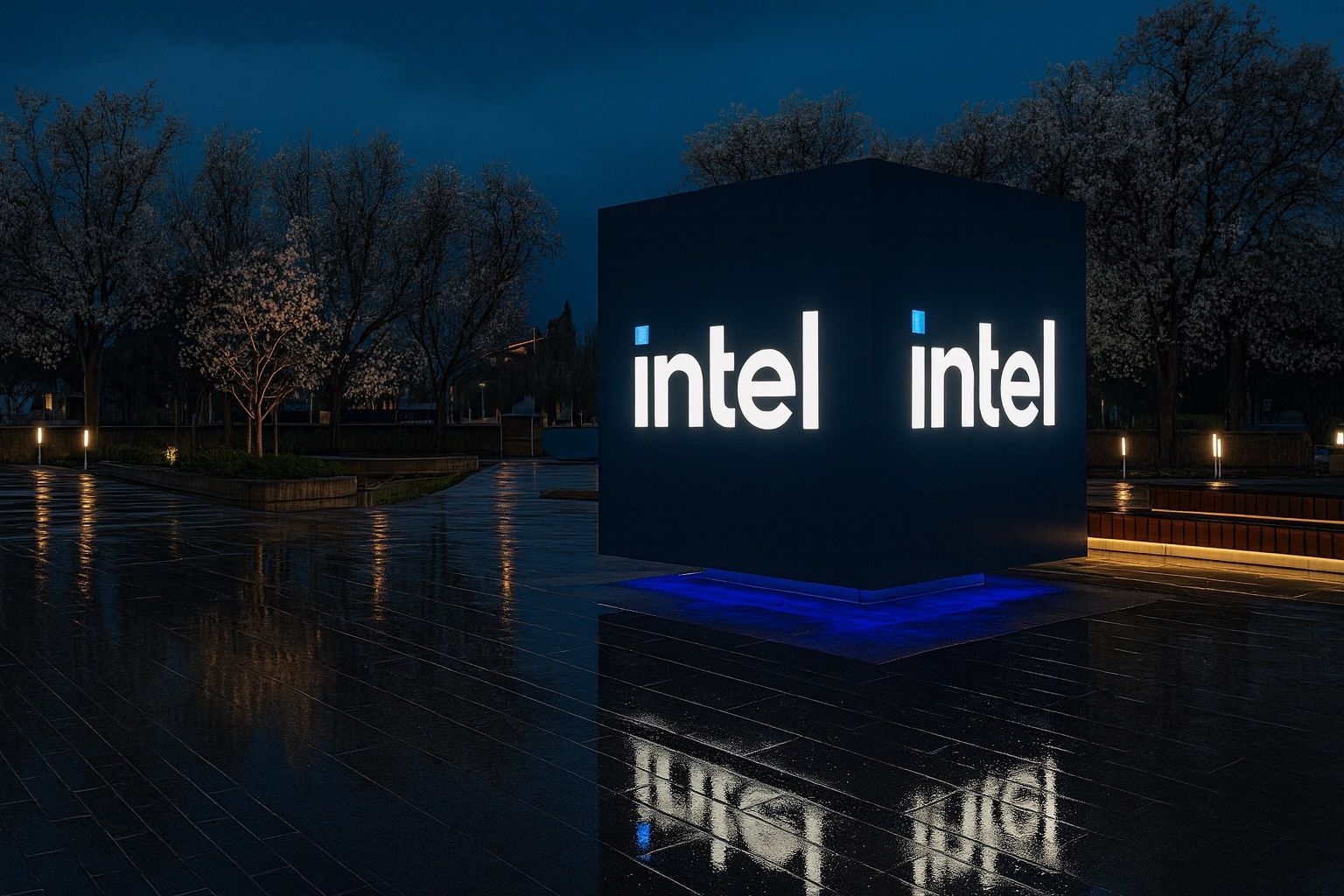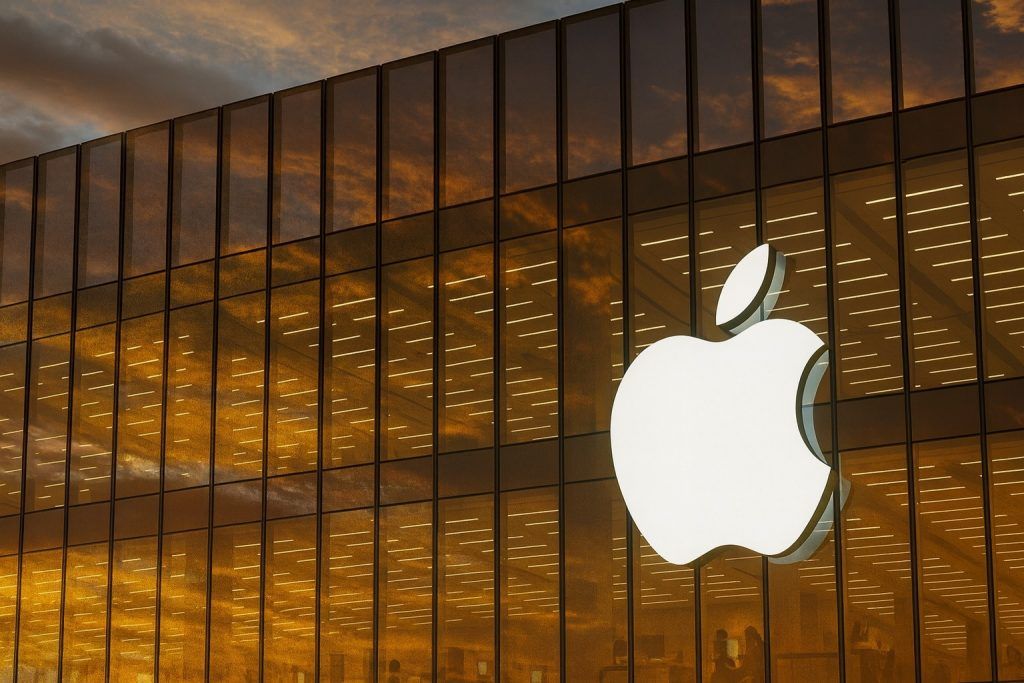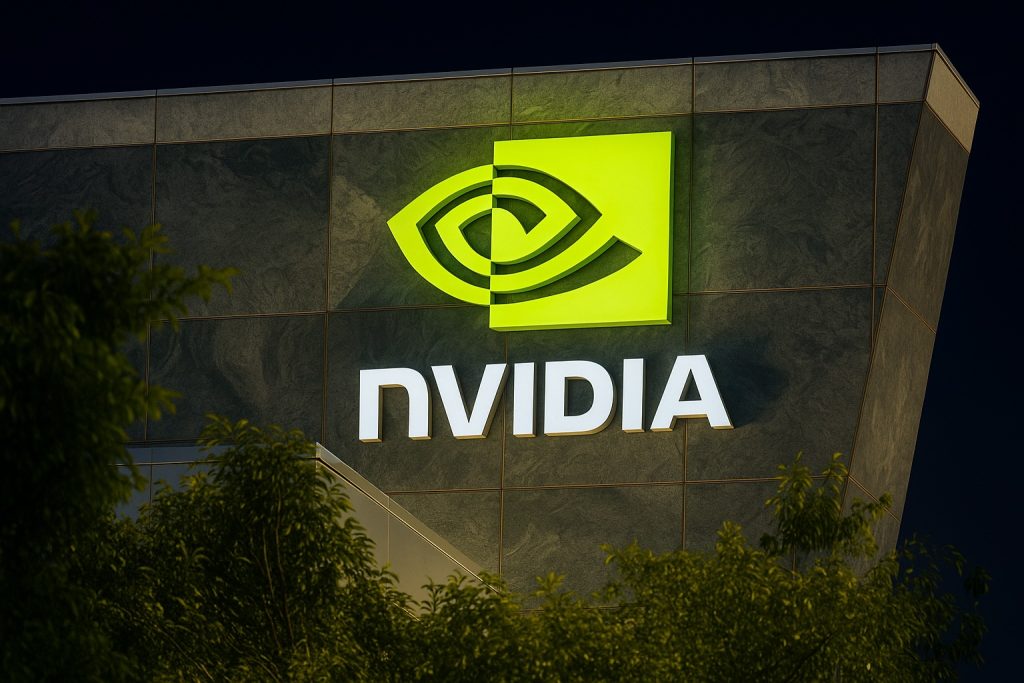- Stock Near 2-Year High: Intel Corporation’s stock (NASDAQ: INTC) closed around $37 as of Oct. 17, 2025, ticking up about 0.7% on Friday. Shares are at their highest level in over two years after nearly doubling from January lows – up roughly 85% year-to-date [1] [2]. The past week was flat overall, after an early October spike to a new 52-week high (~$38) that quickly cooled [3].
- AI Hype & Nvidia Deal Fuel Rally: Investors have bid up Intel on excitement around artificial intelligence. This week, a report hinted that Intel’s foundry unit secured a major AI chip customer – rumored to be Microsoft for its Azure cloud – giving the stock a modest lift [4]. And in mid-September, Nvidia took a $5 billion stake (~4%) in Intel as part of a partnership to co-develop chips that combine Intel CPUs with Nvidia GPUs [5]. That surprise alliance – a strong vote of confidence from a top rival – sent Intel shares soaring 22.8% in one day (Sept. 18), the biggest single-day jump since 1987 [6].
- Big Backers Pile In: In an unprecedented move, the U.S. government is acquiring roughly a 10% stake in Intel (about a $10 billion investment via the CHIPS Act) to bolster domestic chipmaking [7]. SoftBank’s Vision Fund added a $2 billion equity stake earlier this year [8]. Intel has even courted Apple – preliminary talks about an investment or foundry deal were reported in late September, sending Intel stock up 6% on the rumor [9]. These infusions from Washington, Big Tech and finance have buoyed sentiment (while raising questions about political influence on Intel’s business) [10] [11].
- Mixed Financial Picture: Intel’s latest earnings highlight a slow turnaround. Q2 2025 revenue was $12.9 billion (flat year-on-year) with gross margins under 30%, and the company remained unprofitable [12]. New CEO Lip-Bu Tan – appointed in early 2025 – has slashed costs, cutting ~20% of Intel’s workforce (targeting ~75,000 employees by year-end) [13]. He also paused some new fab projects to conserve cash [14]. Intel doesn’t expect to return to profitability until 2026 [15]. Q3 2025 results are due next week (Oct. 23), with Intel guiding for a slight revenue uptick but a deeper loss [16], underscoring the challenge to improve margins.
- Rivals Thriving in AI Boom: Intel’s rally comes as competitors also soar amid a global chip boom. AMD shares just hit an all-time high around $240 after scoring blockbuster AI chip deals (e.g. supplying OpenAI and Oracle) [17], and some bulls predict AMD could reach $300. Nvidia still dominates the AI processor market with an estimated 90% share of data-center GPUs [18], and its market cap (over $1 trillion) reflects sky-high growth expectations. By contrast, Intel’s market value (~$175 billion) is about half of AMD’s and only a fraction of Nvidia’s [19]. Even Qualcomm, focusing on mobile, automotive and IoT chips, has enjoyed strong 2025 performance largely insulated from Intel’s challenges [20].
- Analysts Cautious on Outlook: Despite Intel’s rebound, Wall Street remains wary. The consensus 12-month price target is only about $26 – ~30% below current levels [21] – and the vast majority of analysts rate the stock a Hold or Sell. Skeptics call the surge “deal-driven” and point to ongoing execution risks [22]. For example, HSBC downgraded Intel to “Reduce” in October, and Citi to “Sell,” arguing that recent gains don’t fix Intel’s manufacturing woes [23]. However, a few optimists see room for upside: UBS raised its target to $40 on foundry optimism [24], and the most bullish forecasts range as high as $43 [25]. Notably, Jim Cramer has praised CEO Tan as a “legendary semiconductor investor” for securing big strategic deals that “sparked a roughly 50% rally” [26]. Still, until Intel proves it can close the tech gap with rivals, many experts see the stock’s AI-fueled run as fragile [27] [28].
Intel Stock Price & Recent Performance
Intel’s share price has been on a roller coaster in recent days, reflecting excitement about its prospects tempered by bouts of profit-taking. As of the Oct. 17 market close, INTC traded in the high-$36 range [29], roughly flat for the week. The stock nearly hit $38 earlier in the month – a new 52-week high – after reports on Oct. 2 that Intel was in talks to have AMD as a chip fabrication customer (a once-unthinkable Intel-AMD foundry deal) [30]. That headline sent Intel shares up almost 4% intraday [31]. However, the rally faded just as quickly when Deutsche Bank warned the stock had climbed “too far, too fast,” reiterating a Hold rating with a $30 price target and urging investors to take profits [32].
Even with this recent volatility, Intel has been a standout performer in 2025. At ~$37, the stock has nearly doubled from its lows in January, delivering about an 85% year-to-date gain [33]. This far outpaces the broader market and marks a dramatic reversal from 2022–2023 when Intel was mired in declines. The rally really accelerated in late summer 2025, coinciding with Intel unveiling major strategic moves and a general wave of optimism for tech stocks amid the AI frenzy [34]. Long-term Intel shareholders, however, remain under water — the stock is still well below its peaks from a few years ago before the slide began [35]. The key question now is whether the recent uptrend signifies a sustainable turnaround or just a short-lived “AI-fueled sugar high” [36]. Many on Wall Street are debating if Intel’s momentum can continue or if a pullback is overdue.
Major Catalysts: AI Deals, Partnerships & Government Support
Several headline-grabbing developments have underpinned Intel’s comeback story this year. The biggest theme is AI – an area where Intel had lagged but is now scrambling to catch up. Below are the key catalysts that have fueled Intel’s stock rally in recent months:
- Rumored Big AI Customer: In mid-October, market chatter suggested that Intel’s foundry division (which makes chips for outside clients) finally secured a “major AI chip customer” for its upcoming 18A process node [37]. Industry insiders speculate that client is Microsoft, potentially for the custom AI accelerators used in its Azure cloud [38]. Intel had announced Microsoft as a partner for its 18A process back in 2024, but progress had been unclear. The new reports hint that Intel might actually produce advanced AI chips for Microsoft’s data centers – a huge credibility boost for Intel’s foundry business if it pans out. Just the prospect of this deal gave Intel’s stock a lift heading into the weekend [39], as investors imagined Intel becoming a viable player in the booming AI infrastructure arena currently dominated by Nvidia and AMD.
- Nvidia’s $5 Billion Stake: The blockbuster development that truly put Intel back on traders’ radar was a partnership with Nvidia, the world’s leading AI chipmaker. In mid-September, Nvidia agreed to invest $5 billion in Intel, acquiring roughly a 4% equity stake [40]. The deal – astonishing to many given the companies’ longtime rivalry – is centered on co-developing next-generation PC and data center chips that combine Intel’s CPUs with Nvidia’s GPUs [41]. Notably, Nvidia is not moving its own GPU manufacturing to Intel (the partnership doesn’t directly utilize Intel’s foundry fabs) [42]. Even so, the alliance was a strong vote of confidence in Intel’s technology roadmap. For Nvidia, it secures influence at a key supplier and a hedge against over-reliance on TSMC; for Intel, it brings the imprimatur of the AI industry leader and potential design wins down the road. The market reaction was euphoric – Intel’s stock soared 22.8% in a single day on the news, its biggest one-day gain since the 1987 crash [43]. That dramatic pop showed how much optimism the Nvidia alliance injected into Intel’s narrative.
- U.S. Government Stake: In late August, the U.S. government made a highly unusual move to prop up Intel as a domestic “national champion” in semiconductors. The Biden administration (under President Donald Trump’s second-term leadership in this timeline) engineered a deal converting about $10 billion of CHIPS Act subsidies into an equity stake in Intel [44] [45]. In effect, Washington is purchasing roughly a 9.9% stake in the company [46]. Intel’s CEO and board agreed to the dilution in exchange for the large cash infusion and strategic backing. The investment aims to ensure the U.S. has a home-grown producer of advanced chips for economic and national security reasons. Markets initially viewed the government stake as a bullish signal that Intel is “too important to fail.” However, it has also raised concerns: Intel acknowledged in SEC filings that having Uncle Sam as a major shareholder could deter some overseas customers or subject the company to new regulations [47] [48]. The move essentially politicizes parts of Intel’s operations – some foreign clients see a U.S. government ownership as a red flag, fearing Intel could act as an arm of U.S. policy [49]. Despite those worries, the CHIPS Act stake underlined the government’s confidence in Intel’s revival and gave the stock another sentiment boost.
- SoftBank and Apple Involvement: Following the government’s lead, other big-name investors have jumped in. SoftBank – via its Vision Fund – poured $2 billion into Intel stock in early September [50]. And in late September, Bloomberg reported that Intel had approached Apple about a possible investment or foundry partnership [51]. The talks were very preliminary (and Apple later signaled its focus remains on its own silicon built at TSMC), but just the rumor of Apple’s interest sent Intel shares up 6% on Sept. 24 [52]. Apple’s motive would likely be to diversify its chip supply chain beyond Taiwan, so a tie-up with Intel, even as a minority stakeholder or customer, would carry huge symbolism. While no deal materialized yet, the Apple speculation added to the hype surrounding Intel’s turnaround. In sum, Washington, SoftBank, Nvidia, and potentially Apple lining up behind Intel has given the company something it lacked for years: a sense of momentum and vote of confidence from industry heavyweights.
- AMD Foundry Rumors: In early October, another jaw-dropping storyline surfaced – one that would have been laughable just a few years ago: Intel and AMD in talks about a chip manufacturing deal. On Oct. 1, a Reuters report (via Semafor) claimed AMD is in early discussions to use Intel’s foundry services for some of its chips [53]. Both companies declined to comment and no details have been confirmed [54]. But the mere possibility that AMD – which has overtaken Intel in certain chip segments – might become a customer of Intel’s fabs speaks volumes about industry dynamics. It suggests AMD is looking to diversify production beyond TSMC (similar to Apple’s logic) and that Intel’s new strategy of opening its fab doors to rivals may be gaining traction. This rumor helped boost Intel’s stock in early October. However, as noted, analyst caution (like Deutsche Bank’s quick “Hold” call) tempered the rally [55]. Still, the fact we’re even talking about AMD and Intel partnering underscores how dramatically Intel’s approach has shifted in the face of geopolitical and competitive pressures.
These catalysts have collectively driven a re-rating of Intel’s prospects. They illustrate Intel’s new playbook: embrace partnerships (even with rivals), seek outside investment, and leverage government support – all to regain its footing in a transformed semiconductor landscape.
Broader Market & Sector Context
Intel’s resurgence is happening against a backdrop of booming optimism for the semiconductor sector, especially anything related to AI. After a multiyear downturn, chip stocks have roared back in 2025, powered by insatiable demand for advanced processors in data centers, cloud AI, and edge devices. The Philadelphia Semiconductor Index (SOX) and Nasdaq have notched record highs recently as AI becomes the “picks and shovels” trade of this era [56].
A prime example came this week when TSMC, the world’s top contract chipmaker, reported blowout earnings and raised its outlook on strong AI demand. TSMC’s CEO noted that orders from AI chip giants like Nvidia and big cloud players are driving structural growth, not just a transient spike [57] [58]. This rosy forecast from TSMC sent semiconductor stocks broadly higher in mid-October [59]. It’s clear that nearly three years after ChatGPT’s debut kicked off an AI arms race, the momentum is still accelerating. Big Tech firms and startups alike are racing to build ever-larger AI models and infrastructure, which in turn is fueling massive investment in chips, servers, and data centers [60]. As one market analyst put it, “This is no longer a cyclical upturn – it’s structural” [61].
In this environment, even legacy chipmakers like Intel have been lifted by the rising tide. However, Intel’s situation is unique. Unlike pure-play AI winners (Nvidia, AMD) or specialty foundries (TSMC), Intel is a hybrid – it’s trying to reinvent itself as both a chip design house and a contract manufacturer (foundry) through its IDM 2.0 strategy. The broader market context provides both opportunity and pressure for Intel. On one hand, the AI boom means there’s huge business up for grabs if Intel can deliver competitive products (and a viable alternative to TSMC for manufacturing). This is part of why the U.S. government and companies like Nvidia are backing Intel – to ensure more diversified, resilient chip supply chains [62]. On the other hand, the overall sector’s high valuations and growth expectations set a high bar. Investors now expect Intel to execute on AI initiatives and meet the standards set by rivals. If it falls short, the broader rally could leave Intel behind again.
Geopolitics also loom large. The U.S.-China tech tensions and risk of supply disruptions in Taiwan have made Intel’s U.S.-based fabs strategically important. Many U.S. fabless companies (Apple, Nvidia, Qualcomm, AMD) rely on TSMC’s Asian facilities for cutting-edge chips; they now view Intel as an “insurance policy” in case geopolitical events threaten that supply [63]. This has opened the door for Intel to win partnerships (as seen with Nvidia, and possibly others). But to capitalize, Intel must quickly improve its manufacturing technology to TSMC’s level. The CHIPS Act and government stake reflect a broader policy push to onshore more semiconductor production in America. In short, the semiconductor boom and geopolitical climate provide a window of opportunity for Intel – but also cast Intel’s performance as a matter of national interest, adding pressure not to stumble.
Competitive Landscape: Intel vs. AMD, Nvidia, Qualcomm
Intel’s steep climb in stock price comes as its rivals are also enjoying strong gains – and in some cases, outpacing Intel on the technological front. Here’s a look at how Intel stacks up against some key competitors:
- AMD (Advanced Micro Devices): Long Intel’s nemesis in PC processors, AMD has emerged as a leader in high-end GPUs and data-center chips as well. In 2025, AMD’s stock hit record highs (around $240 per share) [64] on the back of major wins in AI. AMD clinched multi-year deals to supply its new MI300 AI accelerators to marquee clients like OpenAI (the company behind ChatGPT) and Oracle’s cloud [65]. These deals turbocharged sentiment on AMD – some Wall Street analysts now predict AMD could reach $300 a share [66]. Beyond AI, AMD continues to chip away at Intel’s CPU dominance: it has gained PC market share with its Ryzen processors and is a formidable player in server CPUs with EPYC chips. Ironically, AMD’s success is part of what pressured Intel to pursue unorthodox moves (like the foundry partnership talks). AMD’s market capitalization has swelled to roughly double Intel’s, reflecting how much investor confidence shifted. While Intel still far outsells AMD in unit volume, in the eyes of the market AMD is now valued as the more promising growth story. AMD’s challenge will be executing on its huge opportunities (it too relies on TSMC for manufacturing, and U.S. export curbs on high-end chips to China have clipped some of its near-term sales). But for now, AMD is widely seen as a big beneficiary of the AI revolution, intensifying the pressure on Intel’s comeback efforts [67] [68].
- Nvidia: In the AI era, Nvidia is the undisputed king. The company that invented the GPU has leveraged that technology to dominate AI computing – its GPUs are the workhorses training and running most large AI models. Nvidia’s stock has been one of the top performers of the past two years, and in 2025 it briefly joined the elite club of companies valued over $1 trillion. Nvidia’s data-center revenue is booming (forecast to hit record levels) thanks to seemingly insatiable demand for AI chips like the A100 and H100. By some estimates Nvidia commands 90%+ of the market for AI accelerators used in data centers [69]. Its lofty valuation – around 50× earnings – reflects investors’ almost boundless growth expectations [70]. In this context, Nvidia’s decision to invest in Intel was both surprising and strategic. As noted, it gives Nvidia a stake in Intel’s manufacturing resurgence and could make Intel a secondary source for certain chips, diversifying Nvidia’s supply chain beyond TSMC [71] [72]. For Intel, partnering with the industry leader lends instant credibility to its technology efforts. But it’s important to note that Nvidia remains a competitor too: it continues to push ahead with its own chip development (GPUs, AI systems, networking) at a pace Intel will struggle to match in the short term. Nvidia’s success has set a high bar – one that Intel is now trying to clear by developing competitive AI silicon (like its upcoming “Crescent Island” GPU for AI inference, planned for 2026 [73]). Thus far, Nvidia’s dominance appears intact, but if Intel can execute, the Nvidia-Intel collaboration could prove mutually beneficial. Many analysts, however, caution that Intel’s rally has been driven by the Nvidia deal hype more than by tangible results – a reason some have downgraded the stock, saying the partnership alone doesn’t solve Intel’s core challenges [74] [75].
- Qualcomm: While much of the spotlight is on the AI battle between Intel, AMD, and Nvidia, Qualcomm represents a different corner of the chip industry – and a competitor in specific areas. Qualcomm is the leader in smartphone processors and wireless modems, markets where Intel has either struggled or exited (Intel sold its mobile modem business in 2019, for instance). In 2025 Qualcomm has been performing solidly; it’s riding growth in automotive chips, IoT devices, and 5G handsets, and is also venturing into AI at the edge (bringing AI features to phones and cars). Qualcomm’s latest earnings showed strength in those segments, and the company has expressed optimism about AI-enabled devices on the edge of the network [76]. Importantly, Qualcomm doesn’t compete head-to-head with Intel in PC or server CPUs, so it’s somewhat insulated from Intel’s woes [77]. In fact, Qualcomm relies on TSMC and Samsung for fabrication and is part of the fabless cohort that might indirectly benefit if Intel’s foundry business gains traction (more competition among foundries could lower costs or improve capacity for everyone). For investors, Qualcomm is often seen as a steadier chip stock focusing on mobile and connectivity, whereas Intel is a turnaround story in CPUs and data centers. Qualcomm’s stock hasn’t seen the same “AI hype” pop as Intel’s, but it also hasn’t faced the deep skepticism – its business is viewed as more stable in the near term. In summary, Qualcomm’s success in its niche underscores that the semiconductor boom extends beyond just AI superchips, and it highlights that Intel’s competitive landscape spans not only its traditional PC rivals but also new fronts like mobile and automotive if Intel ever decides to re-enter those arenas.
Earnings and Turnaround Efforts
For all the market excitement about new deals and AI opportunities, Intel’s financial fundamentals remain a work in progress. The company is still emerging from one of the toughest periods in its history – characterized by falling revenues, eroding margins, and heavy losses in 2022–2024. In the most recent quarter (Q2 2025), Intel showed some tentative signs of stabilization: revenue came in at $12.9 billion, which was flat compared to a year prior (ending a streak of revenue declines) and slightly above Wall Street’s muted expectations [78]. However, profitability is still elusive. Intel’s gross profit margin in Q2 was under 30%, a far cry from the 55–60% gross margins it consistently enjoyed in its heyday [79]. After accounting for operating expenses, Intel posted a net loss for the quarter [80]. This means the company has now logged multiple consecutive quarters of red ink.
The bleeding has prompted aggressive action. CEO Lip-Bu Tan, who took the helm in early 2025, has been in full turnaround mode. Tan is a well-regarded semiconductor industry veteran (known as an investor and formerly the CEO of Cadence Design Systems), and he wasted no time in cutting costs. Under his watch, Intel has implemented massive layoffs and spending cuts – over 20% of the workforce is being trimmed, with Intel aiming to end 2025 with around 75,000 employees versus ~100,000+ not long ago [81] [82]. Tan also hit the brakes on expensive capital projects not deemed immediately necessary. For example, Intel has slowed construction of new chip fabs in Ohio, Germany, and Poland – multibillion-dollar projects that were announced during better times – to conserve cash and focus on nearer-term returns [83]. “No more blank checks,” Tan has told employees, emphasizing disciplined investment over grand expansion [84]. Capital expenditures have been refocused on critical roadmap technologies and fulfilling the sizable orders/opportunities from partners like the U.S. government and Nvidia.
These belt-tightening moves have started to improve Intel’s cost structure, but the benefits won’t fully show until future quarters. In the meantime, Intel’s core businesses are still facing headwinds. The PC market, while stabilizing, is not in a high-growth phase, and Intel continues to lose some share to AMD in client CPUs. In data center/server chips, Intel’s latest Xeon processors are competitive but have had a slower uptake, and AMD’s EPYC line has made inroads with certain cloud customers. Perhaps most significantly, Intel’s ambitious foray into foundry services (IFS) – opening its fabs to make chips for others – is still in its infancy and running at a loss. Intel has been investing heavily to stand up IFS, but until big customers (like the rumored Microsoft or maybe even AMD) materialize and fill those fabs with orders, it remains a drag on earnings. The upcoming Q3 2025 earnings (set for Oct. 23) will be closely watched for progress on these fronts. Analysts expect Intel to report another quarterly loss (consensus is for a GAAP net loss), and possibly a slight year-over-year revenue decline [85]. Intel’s own guidance was for a modest sequential uptick in revenue but a wider loss as cost cuts take time and certain expenses (like 18A development and factory tool installs) weigh on the P&L [86].
One bright spot is that Intel’s inventory levels and PC client division may see a boost from the back-to-school and holiday PC demand, which has shown signs of life. Additionally, any concrete news of new foundry customers or faster progress on AI chips could help the narrative. But by and large, Intel’s near-term financial story is about restructuring and investing for a hoped-for payoff later. The company and its investors are looking toward 2026 and beyond for a return to profitability and growth. Until then, Intel is balancing on a thin line: cutting enough to stem losses, but not so much as to hamper its ambitious roadmap.
On that roadmap, Intel has made some noteworthy product announcements that it hopes will drive future growth:
- In early October, Intel unveiled “Panther Lake”, its next-generation PC processor architecture, slated for laptops in 2026. Panther Lake will be built on Intel’s cutting-edge 18A process (18-ångström, roughly equivalent to 2nm) for the CPU cores, combined with external TSMC-made tiles for graphics [87]. Intel is touting Panther Lake as a leap forward in performance per watt, with a refined hybrid core design and improved AI acceleration on-chip. However, this announcement was tempered by reports (via Reuters) that Intel’s 18A manufacturing is struggling with low yields – meaning many chips are coming off the line defective [88]. If true, that raises concerns about Intel’s ability to produce Panther Lake chips at scale and at good margins. Some analysts say Intel may even have to rely more on TSMC or delay certain products if 18A yield issues aren’t solved [89]. Intel insists it’s on track with 18A, but yield is a key metric everyone will be watching.
- Intel also recently revealed it’s working on a new data-center AI chip code-named “Crescent Island.” Set to launch in 2026, Crescent Island is not a CPU but a specialized AI GPU aimed at accelerating machine learning inference in cloud servers [90]. It’s designed to be power-efficient and slots into Intel’s broader AI hardware lineup below the supercomputer-grade processors. This is significant because it shows Intel expanding beyond traditional CPUs to go after Nvidia’s stronghold in AI accelerators. Still, 2026 is a long way off in tech, and Intel will face stiff competition not just from Nvidia but from AMD (which is shipping its MI300 AI chips now) and startups in the AI chip space. The delayed timing of Intel’s high-end AI products (for instance, its first 18A-based server CPU, code-named Clearwater Forest, was pushed to 1H 2026 from an earlier 2025 target [91]) has fueled skepticism. It suggests that Intel’s turnaround in cutting-edge products might not fully materialize until mid-decade, leaving an execution gap that rivals can exploit.
In summary, Intel’s management under Tan is aggressively trying to right-size the company and invest in future tech simultaneously – a tough balancing act. The stock’s 2025 rally shows investors are giving some credit to these efforts, but the real proof will come in the earnings reports of coming quarters. If Intel can show improving margins, on-time product launches, and maybe even some quarters of profit in 2026, it would validate the current optimism. If not, the market’s patience could wear thin.
Wall Street’s View: Skepticism vs. Hope
Given all these cross-currents, it’s no surprise that Wall Street analysts are divided on Intel’s prospects – though the tilt is more cautious than euphoric. According to data from TipRanks and MarketBeat, out of dozens of analysts covering Intel, very few rate it a “Buy” at the moment. Most have Hold/Neutral ratings, and a significant number still advise Sell/Underperform. The average 12-month price target across analysts is around $28–$29 per share [92], which is 20–25% below Intel’s current trading price in the high-$30s. This implies that many experts think Intel’s stock has overshot its near-term fundamentals.
Indeed, since the stock’s big run-up, several analysts have downgraded Intel or voiced caution. For example, HSBC cut its rating on Intel to “Reduce” (essentially a Sell) in October, calling the rally “deal-driven” and arguing that one-off investments from Nvidia or the government don’t resolve Intel’s structural issues in manufacturing [93]. Citi likewise downgraded to Sell, expressing skepticism about the long-term viability of the Nvidia partnership and whether Intel’s foundry business can ever achieve competitive scale [94]. Bank of America lowered Intel to Underperform, citing concerns that Intel still lacks a clear roadmap in AI accelerators and continues to lose share in its core CPU markets [95]. In their view, Intel’s recent moves, while positive, “don’t address the underlying weaknesses” in execution and product leadership [96]. Such bearish analysts often point out that Intel’s valuation – after doubling this year – is now pricing in a successful turnaround that is far from guaranteed.
On the other hand, there are glimmers of optimism among certain analysts and market commentators. UBS made waves on Oct. 6 by raising its price target for Intel to $40 (from the low $30s), citing growing confidence in Intel’s foundry strategy and the strategic importance of its new partnerships [97]. UBS argued that if Intel can secure high-volume foundry clients (like the rumored Microsoft deal) and execute on its roadmap, its earnings power in a few years could justify a higher stock price. A few smaller research outfits and technical analysts have floated even higher upside scenarios – some see a path for Intel stock to reach the $40–$50 range in a bullish case where everything goes right (e.g., 18A yields improve, AI chip sales ramp up, PC market stabilizes) [98]. The most bullish official Wall Street target at the moment is around $43 [99] (from analysts at Benchmark), and the most pessimistic is down at $14 [100] – underscoring the wide uncertainty about Intel’s future.
It’s also worth noting the sentiment from prominent market voices. CNBC’s Jim Cramer, for instance, has turned upbeat on Intel in recent weeks. He praised CEO Lip-Bu Tan’s aggressive moves, calling Tan a “legendary semiconductor investor” who has brought in the partnerships and capital to jump-start Intel’s revival [101]. Cramer suggested Intel’s roughly 50% stock surge under Tan’s short tenure is evidence that “smart money” believes in the strategy [102]. However, even Cramer tempered his enthusiasm by acknowledging Intel has much to prove to regain its past glory. Many analysts echo that sentiment: they’re impressed by Intel’s newfound urgency and the savvy deals orchestrated, but they remain firmly in “show me” mode regarding execution.
In surveys, a common refrain from the cautious camp is that Intel’s stock may have gotten ahead of itself. As one analyst put it, the share price “already reflects a lot of good news” [103] – meaning any slip-up or less-than-stellar news could trigger a pullback. For investors, the bullish case is that Intel is finally on the right track – with a leaner operation, external support, and promising products on the horizon – so those who get in now could benefit if the turnaround truly takes hold by 2026. The bearish case is that Intel still faces fundamental challenges (technological delays, fierce competition, lower margins), and that the recent rally is a temporary pop driven by hype around AI and big headlines, not a sign of a long-term uptrend.
Bottom Line: Intel’s stock has staged a remarkable comeback in 2025, thanks to a flurry of AI-related deals, strategic investments from heavy hitters, and a narrative that the once-slumping giant could become relevant again in the era of AI and advanced manufacturing. This has made Intel one of the year’s hottest tech stocks – a dramatic shift for a company that was often written off in recent years. Yet, as of October 18, 2025, the optimism is tinged with caution. The company’s upcoming earnings and execution over the next few quarters will be crucial in determining whether Intel’s revival is for real. If Intel delivers on the promise of its partnerships and technology roadmap, the stock’s current levels might be justified – or even have further to run. If it stumbles, however, the skeptics warning of an “AI-fueled sugar high” could be proven right, and Intel’s hard-won gains may evaporate. In the high-stakes semiconductor arena, Intel now has both the opportunity and the spotlight – it will need to perform under pressure to keep investors on its side.
Sources: Intel and market data from ts2.tech [104] [105]; Reuters, Yahoo Finance and Bloomberg reports [106] [107] [108]; analyst commentary from MarketBeat/StreetInsider [109] [110] and TipRanks [111]; competitive context from ts2.tech and Reuters [112] [113].
References
1. ts2.tech, 2. ts2.tech, 3. ts2.tech, 4. ts2.tech, 5. ts2.tech, 6. ts2.tech, 7. ts2.tech, 8. ts2.tech, 9. ts2.tech, 10. ts2.tech, 11. ts2.tech, 12. ts2.tech, 13. ts2.tech, 14. ts2.tech, 15. ts2.tech, 16. ts2.tech, 17. ts2.tech, 18. ts2.tech, 19. ts2.tech, 20. markets.financialcontent.com, 21. ts2.tech, 22. markets.financialcontent.com, 23. markets.financialcontent.com, 24. markets.financialcontent.com, 25. www.tipranks.com, 26. ts2.tech, 27. ts2.tech, 28. ts2.tech, 29. ts2.tech, 30. ts2.tech, 31. ts2.tech, 32. ts2.tech, 33. ts2.tech, 34. ts2.tech, 35. ts2.tech, 36. ts2.tech, 37. ts2.tech, 38. ts2.tech, 39. ts2.tech, 40. ts2.tech, 41. ts2.tech, 42. ts2.tech, 43. ts2.tech, 44. ts2.tech, 45. ts2.tech, 46. ts2.tech, 47. ts2.tech, 48. ts2.tech, 49. ts2.tech, 50. ts2.tech, 51. ts2.tech, 52. ts2.tech, 53. ts2.tech, 54. ts2.tech, 55. ts2.tech, 56. ts2.tech, 57. www.reuters.com, 58. www.reuters.com, 59. www.reuters.com, 60. www.reuters.com, 61. www.reuters.com, 62. ts2.tech, 63. ts2.tech, 64. ts2.tech, 65. ts2.tech, 66. ts2.tech, 67. markets.financialcontent.com, 68. markets.financialcontent.com, 69. ts2.tech, 70. ts2.tech, 71. ts2.tech, 72. ts2.tech, 73. ts2.tech, 74. markets.financialcontent.com, 75. markets.financialcontent.com, 76. markets.financialcontent.com, 77. markets.financialcontent.com, 78. ts2.tech, 79. ts2.tech, 80. ts2.tech, 81. ts2.tech, 82. ts2.tech, 83. ts2.tech, 84. ts2.tech, 85. markets.financialcontent.com, 86. ts2.tech, 87. ts2.tech, 88. ts2.tech, 89. ts2.tech, 90. ts2.tech, 91. markets.financialcontent.com, 92. www.tipranks.com, 93. markets.financialcontent.com, 94. markets.financialcontent.com, 95. markets.financialcontent.com, 96. markets.financialcontent.com, 97. markets.financialcontent.com, 98. ts2.tech, 99. www.tipranks.com, 100. www.tipranks.com, 101. ts2.tech, 102. ts2.tech, 103. ts2.tech, 104. ts2.tech, 105. ts2.tech, 106. ts2.tech, 107. ts2.tech, 108. ts2.tech, 109. markets.financialcontent.com, 110. markets.financialcontent.com, 111. www.tipranks.com, 112. ts2.tech, 113. markets.financialcontent.com







